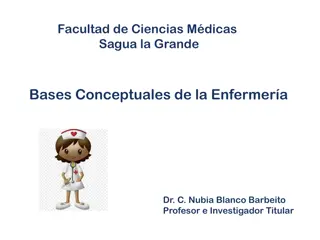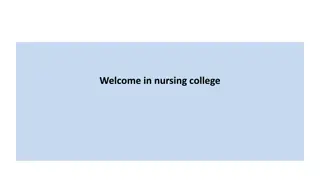Intraoperative Nursing and Safety Considerations
Intraoperative nurses play a critical role in ensuring the safety of clients undergoing surgery by assessing, positioning, monitoring, and managing equipment in the operating room. Factors such as client's age, size, anesthesia type, and surgical site influence the positioning process. Proper handling of surgical supplies, electrical safety, and vigilant monitoring for emergencies are essential components of intraoperative nursing care. Counting and tracking surgical instruments, maintaining a sterile environment, and adapting positions based on the surgical procedure are key responsibilities for these specialized nurses.
Download Presentation

Please find below an Image/Link to download the presentation.
The content on the website is provided AS IS for your information and personal use only. It may not be sold, licensed, or shared on other websites without obtaining consent from the author.If you encounter any issues during the download, it is possible that the publisher has removed the file from their server.
You are allowed to download the files provided on this website for personal or commercial use, subject to the condition that they are used lawfully. All files are the property of their respective owners.
The content on the website is provided AS IS for your information and personal use only. It may not be sold, licensed, or shared on other websites without obtaining consent from the author.
E N D
Presentation Transcript
Often called as operating room nursing Intra operative nurses see the client immediately before surgery and completes initial brief assessment
Major consideration safety Includes 1. Positioning 2. Controlling equipment and supplies 3. Maintaining surgical asepsis 4. Monitoring the physiologic status 5. Monitoring for potential emergencies Positioning Controlling equipment and supplies Maintaining surgical asepsis Monitoring the physiologic status Monitoring for potential emergencies 1. 2. 3. 4. 5.
Essential factors to consider in positioning a client are The site of the operation The age and size of the client The type of anesthesia used Based on the pain site (eg- arthritis)
Dorsal recumbent or supine hernia repair, mastectomy or bowel resection Trendelenberg surgery of lower abdomen and pelvis Lithotomy perineal and rectal areas, vaginal repair, D & C. Prone cervical, spine, rectal, posterior leg Lateral kidney, chest and hip
Positions Changes- Depending upon the type of surgery and visualization of the site Laser techniques, endoscopy or biopsy may require different client positioning Obese patient and operation table should withstand excess weight of the client Provide extra padding to assist skin integrity
Every articles in the operating room can be a source of injury if not used properly So every action must be very carefully done
Counting surgical supplies and equipment (needle, sponges and instruments) Counts are performed by 2 nurses (before incision , during the surgery and immediately before the incision is closed) Final count is announced to the surgeon and charted in the intraoperative chart
Electrical safety All plugs and wires are inspected for correct attachment and working condition Check all equipments are in working condition or not Measures should take to prevent electrical burns
All equipments must be sterile Sterile technique to minimize post op infection by all members
Members of surgical team (surgeon, assistant, scrub personnel) must be in sterile area Circulating nurse is not sterile but monitor the sterile field helps to maintain sterile technique of supplies and personnel
Surgical wounds may closed with sutures, staples or other materials or may be left open to heal by secondary intention. Drains The drain is chosen by surgeon and is based on the size of the wound and the type of the drainage expected Monitor the patency of drain and characteristics of pain even after transferring from OT Drains
Body temperature hypothermia OT- cool level 60-75 degree f Humidity 50-60% Provide appropriate covering Irrigation solution must be warmed to maintain body temperature Surgery for large body burns and infants surgery 90 degree f
Nausea and vomiting Anaphylactic reaction Hypoxia and other respiratory complications Disseminated intravascular coagulopathy
Perform surgical hand washing Do not touch anything that likely to be unsterile after scrubbing Gown insert both hands simultaneously into the arms of the gown after opening it fully Ask the circulating nurse to tie it at the back Wear left glove then the right hand glove After this do not come in to contact with unsterile things including personnel, articles furniture and walls.
Inspect the instruments and other article on the trolley and make sure that all necessary things are there Count sponges and gauze pieces twice along with circulating nurse
Note the number of the articles on the black board and in the record /chart. Do this for all instruments too Special instruments should be find out from the surgeon (eg-retractors and other accessories, instruments, sutures, drains, catheters, etc)
Check OT table accessories are readily available Positioning self mayo s stand etc easy reach to avoid coming in to contact with personnel who have not scrubbed
Be neat, careful and practical in performing Be alert and observant throughout the procedure and follow the steps carefully Be aware of the number of instruments, sponges, gauze pieces in use or discarded Handle all instruments with care minimize injury to self and to the patient handover and receive the sharp instruments in container
See that drapes are firmly fixed with towel clips Fix a sterile screen to separate the anesthetists territory from the surgical field if possible Change gloves immediately if they become punctured or torn. Change drapes if they become wet Keep separate container to discard sponges, gauze pieces, blunt things and sharp things
At the end of the procedure check the instruments and other utensils are properly used and replaces it to the containers. Take the help of circulating nurse for this and record everything See that all things such as the suction, diathermy etc have been switched off and disconnected before shifting the patient
Consult the anesthetist and obtain his permission before turning or shifting the patient Be present till the patient is safely transferred to the stretcher and moved out of the OR. RECORD all incidents and steps See that electrical gadget are switched off before leaving the theatre Report to senior incharge at the end of every operation
Any untoward incidents, injury, loss, breakage, damage and malfunction should be reported and recorded immediately Universal precautions are a must reusable articles have been in contact with potentially infective material Gloves, syringes, catheters, needles and scalpel blades are meant for single use and must be discarded safely
See that OR is cleaned properly by the helper and kept ready quickly for the next case. Doubts and questions should can be clarify with the surgeon at the end.
An interested, dedicated, intelligent, cheerful and hardworking OT nurse be the best possible surgical assistant An interested, dedicated, intelligent, cheerful and hardworking OT nurse be the best possible surgical assistant
Drains are usually used when there is some body fluid, which need to be prevented from collecting. Fluids may accumulate as a results of various pathologies including ascites, peritonitis, abscess formation, hematoma and or from a surgical site.
Glove drain or Used in superficial site eg:- surgical incision of superficial abscess Glove drain or penrose penrose drain drain
Corrugated rubber drain Used in deeper abscess cavities Eg- gluteal abscess, breast abscess etc Corrugated rubber drain
Tube suction drain Tube suction drain Usually small caliber-romovac romovac Connected to vacuum container Eg-intra abdominal collections, after thyroidectomy, mastectomy etc
Wider bore tube drain Used to drain bowel - gastrostomy, oesophagostomy or peritoneal or pleural cavity Wider bore tube drain
Saratoga sump Suction tube drain which consist of 2 concentric tubes, the outer one of which has a side hole and the second one has multiple holes This is a variety of suction tube with does not get easily blocked by things like blood clots Saratoga sump
Salem tube drain Used as an alternative to the Ryle s tube for nasogastric drainage and feeding Salem tube drain
T tube ( T shaped tube which is used to drain the common bile duct after it has been opened and explored during surgery on the biliary duct T tube (kehr kehr) )
It is having a bulb, a tube in which end is having several hole for drainage of fluid, a cap which is sealed and opened when the bulb is filled























